Synthesis and antimicrobial activity of new piperazine-based heterocyclic compounds

Göster/
Erişim
info:eu-repo/semantics/openAccessTarih
2017Yazar
Özdemir, Serap BaşoğluCebeci, Yıldız Uygun
Bayrak, Hacer
Mermer, Arif
Ceylan, Şule
Demirbaş, Ahmet
Karaoğlu, Şengül Alpay
Demirbaş, Neslihan
Üst veri
Tüm öğe kaydını gösterKünye
Özdemir, S. B., Cebeci, Y. U., Bayrak, H., Mermer, A., Ceylan, S., Demirbaş, A., ... & Demirbaş, N. (2017). Synthesis and antimicrobial activity of new piperazine-based heterocyclic compounds. Heterocyclic Communications, 23(1), 43-54. https://doi.org/10.1515/hc-2016-0125Özet
The hydrazide 5, that was obtained from -1-(4-fluorophenyl) piperazine (1), was converted to the cor-responding carbothioamides 6a-c by the reaction with alkyl(aryl) isothiocyanates. the synthesis of conazole analogs 10a-f was performed via the intermediary of triazoles 7a-c. the condensation of triazoles 7a-c with -several -heterocyclic amines in the presence of formalde-hyde afforded the corresponding N-aminoalkylated tria-zoles 11-14. the effect of different catalysts and solvents on conventional and microwave (MW)-prompted reac-tions was examined. the synthesized compounds were screened for their antimicrobial activities.

















